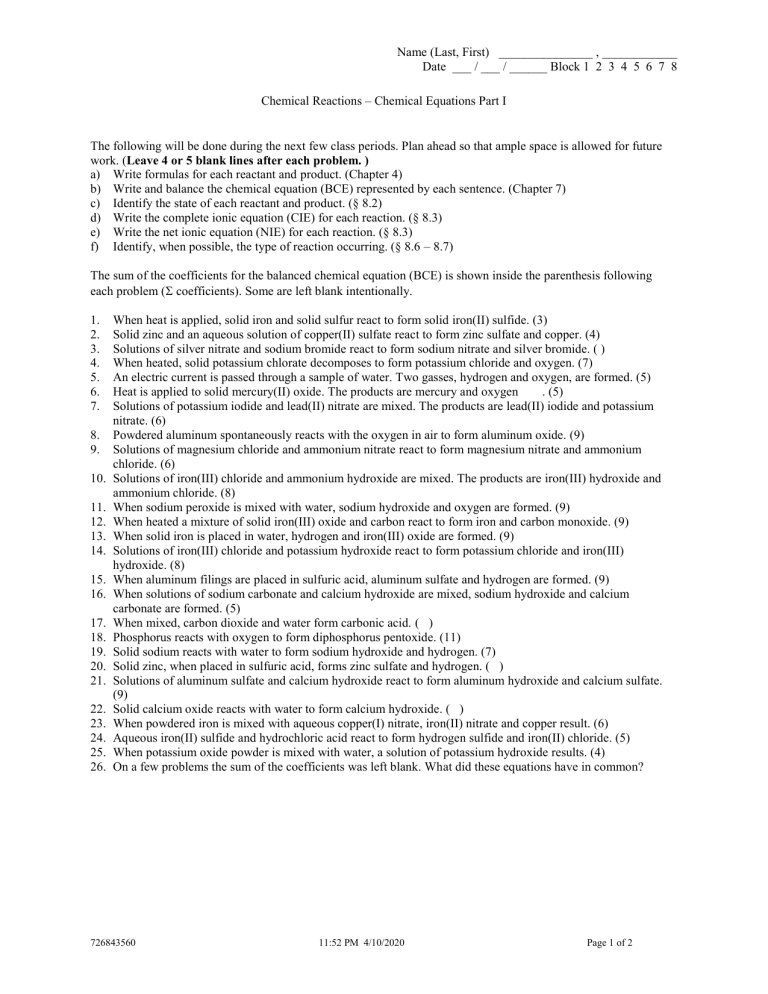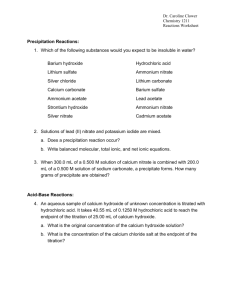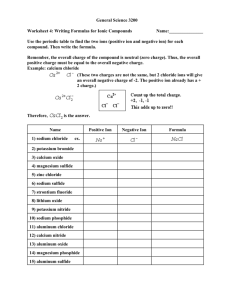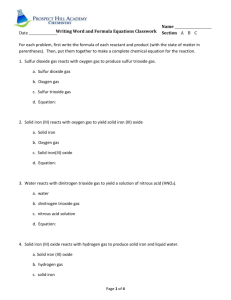Chemical Equations Parts 1 & 2

Name (Last, First) _______________ , ____________
Date ___ / ___ / ______ Block 1 2 3 4 5 6 7 8
Chemical Reactions – Chemical Equations Part I
The following will be done during the next few class periods. Plan ahead so that ample space is allowed for future work. ( Leave 4 or 5 blank lines after each problem. ) a) Write formulas for each reactant and product. (Chapter 4) b) Write and balance the chemical equation (BCE) represented by each sentence. (Chapter 7) c) Identify the state of each reactant and product. (§ 8.2) d) Write the complete ionic equation (CIE) for each reaction. (§ 8.3) e) Write the net ionic equation (NIE) for each reaction. (§ 8.3) f) Identify, when possible, the type of reaction occurring. (§ 8.6 – 8.7)
The sum of the coefficients for the balanced chemical equation (BCE) is shown inside the parenthesis following each problem (
coefficients). Some are left blank intentionally.
1.
When heat is applied, solid iron and solid sulfur react to form solid iron(II) sulfide. (3)
2.
Solid zinc and an aqueous solution of copper(II) sulfate react to form zinc sulfate and copper. (4)
3.
Solutions of silver nitrate and sodium bromide react to form sodium nitrate and silver bromide. ( )
4.
When heated, solid potassium chlorate decomposes to form potassium chloride and oxygen. (7)
5.
An electric current is passed through a sample of water. Two gasses, hydrogen and oxygen, are formed. (5)
6.
Heat is applied to solid mercury(II) oxide. The products are mercury and oxygen . (5)
7.
Solutions of potassium iodide and lead(II) nitrate are mixed. The products are lead(II) iodide and potassium nitrate. (6)
8.
Powdered aluminum spontaneously reacts with the oxygen in air to form aluminum oxide. (9)
9.
Solutions of magnesium chloride and ammonium nitrate react to form magnesium nitrate and ammonium chloride. (6)
10.
Solutions of iron(III) chloride and ammonium hydroxide are mixed. The products are iron(III) hydroxide and ammonium chloride. (8)
11.
When sodium peroxide is mixed with water, sodium hydroxide and oxygen are formed. (9)
12.
When heated a mixture of solid iron(III) oxide and carbon react to form iron and carbon monoxide. (9)
13.
When solid iron is placed in water, hydrogen and iron(III) oxide are formed. (9)
14.
Solutions of iron(III) chloride and potassium hydroxide react to form potassium chloride and iron(III) hydroxide. (8)
15.
When aluminum filings are placed in sulfuric acid, aluminum sulfate and hydrogen are formed. (9)
16.
When solutions of sodium carbonate and calcium hydroxide are mixed, sodium hydroxide and calcium carbonate are formed. (5)
17.
When mixed, carbon dioxide and water form carbonic acid. ( )
18.
Phosphorus reacts with oxygen to form diphosphorus pentoxide. (11)
19.
Solid sodium reacts with water to form sodium hydroxide and hydrogen. (7)
20.
Solid zinc, when placed in sulfuric acid, forms zinc sulfate and hydrogen. ( )
21.
Solutions of aluminum sulfate and calcium hydroxide react to form aluminum hydroxide and calcium sulfate.
(9)
22.
Solid calcium oxide reacts with water to form calcium hydroxide. ( )
23.
When powdered iron is mixed with aqueous copper(I) nitrate, iron(II) nitrate and copper result. (6)
24.
Aqueous iron(II) sulfide and hydrochloric acid react to form hydrogen sulfide and iron(II) chloride. (5)
25.
When potassium oxide powder is mixed with water, a solution of potassium hydroxide results. (4)
26.
On a few problems the sum of the coefficients was left blank. What did these equations have in common?
726843560 11:52 PM 4/10/2020 Page 1 of 2
Name (Last, First) _______________ , ____________
Date ___ / ___ / ______ Block 1 2 3 4 5 6 7 8
Chemical Reactions – Chemical Equations Part 2
The following will be done during the next few class periods. Plan ahead so that ample space is allowed for future work. ( Leave 4 or 5 blank lines after each problem. ) a) Write formulas for each reactant and product. (Chapter 4) b) Write and balance the chemical equation (BCE) represented by each sentence. (Chapter 7) c) Identify the state of each reactant and product. (§ 8.2) d) Write the complete ionic equation (CIE) for each reaction. (§ 8.3) e) Write the net ionic equation (NIE) for each reaction. (§ 8.3) f)
Identify, when possible, the type of reaction occurring. (§ 8.6 – 8.7)
The sum of the coefficients for the balanced chemical equation (BCE) is shown inside the parenthesis following each problem (
coefficients). Some are left blank intentionally.
27.
Aqueous chromium(III) chloride is mixed with sulfuric acid. Chromium(III) sulfate and hydrogen chloride are formed. (12)
28.
Solutions of iron(III) nitrate and ammonium hydroxide react to form iron(III) hydroxide and ammonium nitrate. (8)
29.
Aluminum phosphate and potassium chloride are formed when solutions of aluminum chloride and potassium phosphate are mixed. (6)
30.
Carbon monoxide and aluminum chloride are the products of the reaction between aluminum oxide, carbon, and chlorine. (12)
31.
Copper(I) chloride and water are formed when solid copper(I) oxide is mixed with hydrochloric acid. (6)
32.
Solid magnesium hydrogen carbonate reacts with hydrochloric acid to form magnesium chloride, water, and carbon dioxide. (8)
33.
Solid iron reacts with oxygen in the air to make rust, iron(III) oxide. (9)
34.
Silicon dioxide and hydrogen gasses are formed when silicon is mixed with water. (6)
35.
Rust, iron(III) oxide, reacts with carbon monoxide to form iron and carbon dioxide. (9)
36.
Solid calcium chloride reacts with aqueous chromium(III) nitrate to form calcium nitrate and chromium(III) chloride. (10)
37.
Solid zinc sulfide and oxygen react to form solid zinc oxide and gaseous sulfur dioxide. (9)
38.
When sulfuric acid is added to solid calcium phosphate, calcium sulfate and phosphoric acid are formed. (9)
39.
When iron(III) hydroxide is heated, iron(III) oxide and water vapor are formed. (6)
40.
Aluminum hydroxide, sodium sulfate, and carbon dioxide are the products of the reaction between a solution of aluminum sulfate and powdered baking soda, sodium hydrogen carbonate. (18)
41.
A solution of calcium phosphate is mixed with gaseous silicon dioxide and finely ground carbon. The products are solid phosphorus, solid calcium silicate, and carbon monoxide. (32)
42.
Solid calcium oxide reacts with gaseous sulfur dioxide to form calcium sulfite. (3)
43.
When carbon dioxide is bubbled through a solution of magnesium hydroxide, magnesium carbonate and water are formed. (4)
44.
Calcium chloride and water are formed when solid calcium oxide is stirred into a solution of hydrogen chloride.
(5)
45.
Heated silicon dioxide gas is passed through powdered calcium carbonate. Calcium silicate and carbon dioxide are formed. (6)
46.
When elemental antimony and chlorine are mixed, antimony(III) chloride is formed. (7)
47.
When solid magnesium nitride is poured onto a damp paper towel, solid magnesium hydroxide is formed on the towel and ammonia can be smelled. (12)
48.
A bottle of powdered arsenic is left open by a careless chemist. Later, the chemist discovers that the bottle contains diarsenic trioxide. (9)
49.
Heated ammonium hydrogen carbonate decomposes to ammonia, water, and carbon dioxide. (4)
50.
When heated ammonia gas is forced through finely powdered copper(II) oxide, copper, water, and nitrogen are formed. (12)
51.
When heated ammonium dichromate decomposes to form chromium(III) oxide, nitrogen, and water. (7)
(“Dichromate” is a polyatomic ion. “Di” is not used as a molecular compound prefix in this case. You know this because ammonium is not a nonmetal element. In order for prefixes to be used in the name of a compound, the compound must be molecular. In a molecular compound, both parts of the compound must be nonmetals.)
726843560 11:52 PM 4/10/2020 Page 2 of 2





